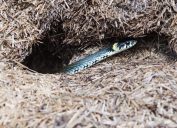Giant Burmese Pythons From South Florida Are "Invading" the North
A dead 8-foot-long snake was found in a north Florida neighborhood.

You don't have to be a nature enthusiast or reptile expert to know that snakes are becoming more curious about their human surroundings. Last year alone, a monster python was found living in a car engine, and a young child was bitten by a copperhead at a zoo playground. But there's an even more ominous threat that's slithering its way into parts of north Florida. For years, experts have warned of a giant Burmese python invasion, and it appears that time has come.
RELATED: Officials Issue "Stark Reminder" That Snakes Are Becoming More Active: "Be Vigilant."
For nearly 25 years, Florida's Everglades National Park has been a breeding ground for Burmese pythons, according to a 2023 U.S. Geological Survey (USGS) report. And now, this invasive species is eager to explore all that north Florida has to offer.
On May 17, the Florida Fish & Wildlife Commission (FWC) was alerted of a Burmese python discovery in Collier County, per NBC-local affiliate WBBH.
General snake sightings aren't uncommon in the Sunshine State. And while the eight-foot-long Burmese python was found dead, its location is what locals are troubled by. The Everglades are situated in south Florida, but the invasive reptile was found over an hour's drive away—making this one of the state's northernmost Burmese python sightings.
And wildlife experts aren't convinced this will be a one-time occurrence. In fact, they believe a Burmese python invasion is afoot.
"I think we will begin to see more pythons in this region soon, I would say this is the invasion front. Maybe they can adapt and live in other types of habitats, we don't know what's going to happen," Andrew Durso, a wildlife biologist with Florida Gulf Coast University, told WBBH.
An apex predator, Burmese pythons feed off mammals like rabbits and mice, as well as larger animals including deer and even alligators. The FWC reports that the snakes "have reduced many mammal populations in the Florida Everglades by as much as 90 percent," per WBHH.
While scientists are calling it an "invasion," the speed and magnitude at which the snakes will move north in Florida remains unknown.
"It's going to depend on the availability of prey in more natural areas," Durso continued. "We know that rabbits and things have declined in the Everglades, and they're still common in these areas. For how much longer? Nobody can really say."
He further theorized: "Maybe the snakes in the Everglades have reached some sort of carrying capacity. When individuals are born, they disperse."
Seth Brattain, who owns and operates the invasive removal service SlethReptiles, told WBHH that he receives three to five snake calls a day during the summer months.
According to Brattain, it all boils down to the snakes' food source. If there are too many Burmese pythons occupying one area, that can decrease the food supply, prompting some reptiles to slither elsewhere for meals.
"It's all about the food source. If they start losing a food source, the population gets too large, they're going to start pushing out to gain more ground. It's an absolute highway," Brattain said.
If you encounter a Burmese python snake, experts strongly advise calling a professional wildlife removal service, who can safely extract the reptile. Wrangling the snake yourself can result in serious injuries and, in some cases, death.
"Do not try and pick them up. They have 180 razor-sharp hook-shaped teeth. They will bite you, they will cut right into your skin, and if not that they'll constrict, and you don't want to get involved in that," cautioned Brattain.





















